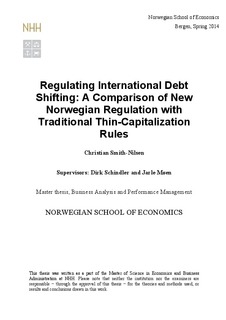| dc.description.abstract | Tax planning behavior, where debt is used to minimize the tax payments, has received
considerable attention in Norway recently. To limit such tax planning behavior, several of
Norway’s largest trading partners have implemented rules to prevent thin-capitalization. This
theoretical thesis presents the general design of the new Norwegian earnings-stripping rules
as well as the main features of traditional thin-capitalization rules.
The predictions from the theoretical modeling show that the new earnings-stripping rules
may restrict excessive use of debt. However, the legal and theoretical review also suggests
that the rules contain weaknesses that hamper the effectiveness. The weaknesses are
primarily that companies can make structural changes to avoid that interest expenses will be
denied deductibility. These structural adaptations involve splitting up assets, substitution
between internal and external debt, and creating organizational structure that makes it
possible to have a higher debt ratio. Briefly reviewing empirical papers provides evidence
that the shortcomings found during the theoretical analysis may limit the effectiveness of the
new Norwegian rules. | nb_NO |
